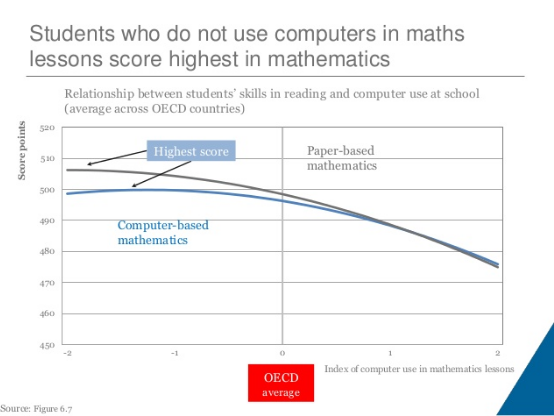Are online mathematics programs damaging early student learning?


There’s a common belief that technology always improves things. It can make things faster, more efficient, more powerful… The list goes on.
With online Mathematics there’s the belief that technology can help us to move away from a traditional model of mathematics instruction and towards a new, personalized and data-driven way of teaching.
In principle, I believe this.
Technology can help us to personalize learning for our students from a young age, and to deliver math programs that fit with their own level and pace. We can use technology to guide students, helping them to understand the steps in solving mathematical problems (not just the answers), even when the teacher is not there.
In practice, this is rarely achieved.
Whilst technology does present tremendous opportunity to improve the way we learn math, there are also plenty of limitations that stem from doing math on a computer or laptop.
The OECD conducted a study comparing PISA results with use of computers for drill based practice and the results are quite shocking. The below graph shows how increased use of computers in class is correlated with lower test scores — particularly for paper based Mathematics exams.

Of course there are a number of reasons for such dire results. One of the big reasons is the widespread adoption of mediocre eLearning tools.
The vast majority of the eLearning tools available to early stage learners have simply created a digital multiple choice or question/answer style platform, rather than exploring the real potential that technology has to offer.
In actual fact as I sit here and write this I realize….
They’re not just mediocre. When used too often, they’re actually really damaging.
In most cases we’d be better off using worksheets with pen and paper rather than overusing eLearning sites that rely entirely on multiple choice.
As educators we need to be more research-based with our interventions and choice of technology. Technology can and should do so much more than multiple choice!
We know from leading researchers like Bloom and John Hattie that personalized instruction, mastery-based learning, formative testing, feedback, and spaced repetition all have a positive effect on student learning.
From a young age students need a learning environment that encourages success. Students become confident with self paced programs. There is no greater feeling than the feeling of mastering a math topic… of understanding the ‘why’ and the ‘how.’
We built Mathspace on this very premise. We wanted to create a math program that fostered continuous improvement. No matter what level you teach, there’s nothing more important than encouraging a growth mindset in students.
Our ‘step by step adaptive learning technology’ automatically adapts math questions to the student’s level and pace. This means that every student can be studying the right question, in the right subtopic and progressing through the development of knowledge at the right pace for them. This encourages students in ways that a multiple choice platform simply cannot.
I put my thoughts into the above video recently — it’s well worth watching and sharing with your staff.
So does technology belong in today’s early learning mathematics classroom?
This really depends on which eLearning programs we use and how we use them.
Any teacher will tell you the importance of showing the working out. By showing working out, misconceptions can be corrected early, and teachers can identify whether misconceptions are isolated to a single student or an entire class.
No matter what grade you teach, the process is just as important as the answer. We need to use eLearning platforms that encourage problem solving, not guesswork. Because the whole point of learning math is to be able to solve problems, not guess the answer based on four multiple choice options.

